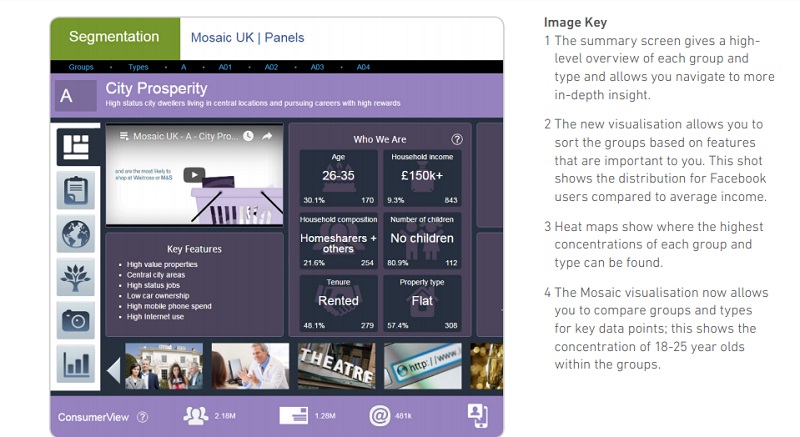Mosaic segmentation

|
| Screen shot of City Prosperity class. Courtesy of Experian. |
Contents |
[edit] Introduction
Mosaic UK is a geodemographic segmentation system devised by marketing services provider Experian to help advance marketing programmes, ensuring that the right information is targeted at the right groups. It is part of a family of Mosaic classifications covering 29 countries including Western Europe, the US, Australia and the Far East.
Mosaic was developed by Richard Webber, a geography professor at Kings College, London, in association with Experian. It is based on the idea that cities globally share common patterns of residential segregation.
[edit] Application
Based on information collected from census, electoral rolls, housing and financial data, Mosaic creates a demographic segmentation which assigns individuals and households into groups and detailed types. This can be used for marketing purposes to target chosen groups with specific information.
Mosaic is said to allow firms to:
- Personalise customer experience to improve retention and share of their spend.
- Understand target audiences and strengthen brand awareness
- Understand new geographic concentrations of customers to optimise location footprint.
Although there are numerous geodemographic segmentation systems, Mosaic is one of the most widely used in the corporate and public sectors, particularly in finance, insurance, retail and telecoms.
[edit] Classification categories
In devising Mosaic, Experian says it identified key demographic changes that influence consumer behaviour. The 2009 version of Mosaic UK has 15 lifestyle (or socio-economic) classifications as follows:
- A – City Prosperity
- B – Prestige Positions
- C – Country Living
- D – Rural Reality
- E – Senior Security
- F – Suburban Stability
- G – Domestic Success
- H – Aspiring Homemakers
- I – Family Basics
- J – Transient Renters
- K – Municipal Tenants
- L – Vintage Value
- M – Modest Traditions
- N – Urban Cohesion
- Q – Rental Hubs
Each of the above classifications is further subdivided, making a total of 66 subclasses. A few examples are as follows:
- A01 – Global high flyers and moneyed families living luxurious lifestyles in London’s most exclusive boroughs.
- C11 – Country-loving families pursuing a rural idyll in comfortable village homes, many commuting some distance to work.
- E21 - Senior singles owning affordable but pleasant homes, whose reduced incomes are satisfactory.
- I39 - Families with children in low-value social houses making limited resources go a long way.
[edit] Mapping
Mosaic data can be overlaid onto maps to highlight the geographic distribution of the chosen parameters and reveal important detail that might otherwise not be discernible. For example, within rural areas, it can highlight households that are likely to be commuting to towns and cities nearby, or residents with more of a local focus i.e in blue collar, agricultural or mining/ manufacturing occupations.
[edit] Related articles on Designing Buildings Wiki
- Mixed-use marketing.
- Property marketing.
- Constructing a three year strategic marketing plan.
- Embedding successful key client management.
- Market segmentation.
- Marketing audit.
- One-year tactical or operational marketing plan.
- Routes to market.
- SWOT analysis.
- Winning work.
[edit] External references
Featured articles and news
Government consultations for the summer of 2025
A year of Labour, past and present consultations on the environment, the built environment, training and tax.
CMA competitiveness probe of major housing developers
100 million affordable housing contributions committed with further consultation published.
Homes England supports Greencore Homes
42 new build affordable sustainable homes in Oxfordshire.
Zero carbon social housing: unlocking brownfield potential
Seven ZEDpod strategies for brownfield housing success.
CIOB report; a blueprint for SDGs and the built environment
Pairing the Sustainable Development Goals with projects.
Types, tests, standards and fires relating to external cladding
Brief descriptions with an extensive list of fires for review.
Latest Build UK Building Safety Regime explainer published
Key elements in one short, now updated document.
UKGBC launch the UK Climate Resilience Roadmap
First guidance of its kind on direct climate impacts for the built environment and how it can adapt.
CLC Health, Safety and Wellbeing Strategy 2025
Launched by the Minister for Industry to look at fatalities on site, improving mental health and other issues.
One of the most impressive Victorian architects. Book review.
Common Assessment Standard now with building safety
New CAS update now includes mandatory building safety questions.
RTPI leader to become new CIOB Chief Executive Officer
Dr Victoria Hills MRTPI, FICE to take over after Caroline Gumble’s departure.
Social and affordable housing, a long term plan for delivery
The “Delivering a Decade of Renewal for Social and Affordable Housing” strategy sets out future path.
A change to adoptive architecture
Effects of global weather warming on architectural detailing, material choice and human interaction.
The proposed publicly owned and backed subsidiary of Homes England, to facilitate new homes.
How big is the problem and what can we do to mitigate the effects?
Overheating guidance and tools for building designers
A number of cool guides to help with the heat.
The UK's Modern Industrial Strategy: A 10 year plan
Previous consultation criticism, current key elements and general support with some persisting reservations.
Building Safety Regulator reforms
New roles, new staff and a new fast track service pave the way for a single construction regulator.
























